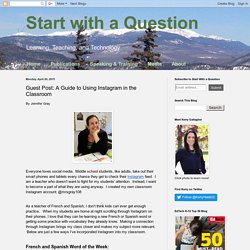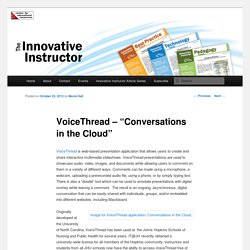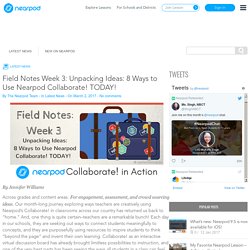

Article 1. Reyes Llopis-Garcia is a lecturer in language and the Co-Director of the Spanish Language Program at Columbia University.

She has used Twitter with her foreign language students to provide real-world analysis, exposure, and reflection of Spanish. This Faculty Spotlight is an excerpt of her conversation with Sarohini Chahal, an educational technologist at CCNMTL, discussing her implementation of the tool and its outcomes. SC: What’s your main goal when you’re teaching? Article 2. Article 3. Article 4. By Jennifer Gray Everyone loves social media.

Middle school students, like adults, take out their smart phones and tablets every chance they get to check their Instagram feed. I am a teacher who doesn’t want to fight for my students’ attention. Instead, I want to become a part of what they are using anyway. I created my own classroom Instagram account: @mrsgray108 As a teacher of French and Spanish, I don’t think kids can ever get enough practice. French and Spanish Word of the Week: I like to introduce a new word about once a week. Study Tips and Reminders: Sometimes I post a picture of the topics on an upcoming quiz as a reminder, and other times I post resources that are available to them. Promote Class Events and Field Trips: Article 5. VoiceThread is web-based presentation application that allows users to create and share interactive multimedia slideshows.

VoiceThread presentations are used to showcase audio, video, images, and documents while allowing users to comment on them in a variety of different ways. Article 6. Rote memorization as a learning strategy has fallen out of favor in recent years, for good reason.

When students cram by memorizing facts for an exam, those memories are often fleeting. Long term memory is built differently. Yet a certain amount of memorization of facts is essential to the foundation of any discipline. There can be multiple layers to the need for these foundational facts in a course. In an introductory class, it is expected that students will learn these facts, but as an instructor you may not want to have them spend valuable class time to this end. Enter Memrise, “…an online learning community where one can learn almost anything in the world, entirely for free! Memrise offers existing courses in languages (including vocabulary, grammar, and culture), arts, literature, math, science, the natural word, history, geography, computers, engineering, law, health and medicine, business and finance, prepping for specific standardized tests, and more. Image source: Memrise logo. Article 7. I am a firm believer, if you give a student the right tools, their creative side will show through.

Recently we have seen this through our schools social network – Yammer in the recent months, proving the value of communication in the school. Yammer itself was probably a bit of a gamble in the school market, my previous school did not see the value in it, however at Wymondham they took the risk. Russell Boulton was aware of what Enterprise Social meant and how we could manage any risk. So Yammer was born in January 2014. Initially usage was limited to our Sixth Formers. How to setup your profilewhat information do you want to make publicwhat posts are applicable This has been rolled out to different year groups during the year, with some students ‘getting ahead of the game’ before hand!
Of course we have teachers who embrace the idea and are happy to utilise Yammer to its upmost. So here is a great example in the Story writing group, taken a few days ago. Article 8. By Jennifer Williams Across grades and content areas.

For engagement, assessment, and crowd sourcing ideas. Our month-long journey exploring ways teachers are creatively using Nearpod’s Collaborate! In classrooms across our country has returned us back to “home.” And, one thing is quite certain–teachers are a remarkable bunch! Article 9. This year I noticed that my AP Spanish (4th year at my school) class had a lower listening proficiency than my previous class.

As I reflected on possible causes for this, I realized that since I’d moved classrooms into a room without a VCR and thus stopped moving slowly through tapes of prior years’ Latin Grammy’s, I had stopped doing listening cloze quizzes of Spanish-language commercials. I wondered if perhaps that could be a contributing factor. To hear the blank words, students would listen to the native Spanish in these commercials over and over and over, and so I wondered if the drop in focused native listening activities had decreased the proficiency. I thought about how to bring this activity back and thought, of course, that these commercials must be on YouTube. As it turned out, I found almost none of the quizzes I had scripted before, but I did find many more.
Let’s see how many teachers and how many commercials we can get in this document. Article 10.